Cooler Master Hyper Z600 Review

New solution from Cooler Master will not leave overclockers unfazed: it can work brilliantly in passive mode and boasts great potential for active cooling. Add superior looks and you get a very attractive product, which we are going to review today.
The manufacturers of processor coolers seem to have realized that they have finally exhausted the potential of these systems on contemporary CPUs. We haven’t come across an air cooler yet that would prove significantly more efficient than the existing solutions, although we have already tested a few dozens of coolers in our labs. As a result, each company tries to find its own way of winning the consumers’ hearts. Some of them use original cooler designs and shapes, others focus on cooling the area around the processor socket in a more aggressive manner, while some introduce all sorts of modding-friendly features.
However, some manufacturers are ready to offer absolutely noiseless passive cooling solutions to those users who are tired of annoying noise generated by their computer systems. In fact, these coolers consist only of a heatsink and have an optional fan at best. In the early days practically the only cooler like that was Scythe Ninja. Then Scythe launched their Orochi, which we are going to review very soon, too. However, not only the Japanese Company was moving in that direction. The well-known Cooler Master announced and launched into mass production their passive cooler called Hyper Z600. out today’s review will be devoted to this particular solution, the peculiarities of its design, its expandability, efficiency in passive and active modes and the whole bunch of other important factors.
Package and Accessories
The front of the relatively small box of the new Cooler Master Hyper Z600 is decorated with an embossed sticker looking like the top view of the actual cooler:
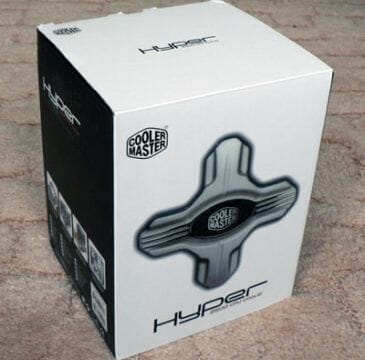
It looks very stylish and original. As far as I understand, Gigabyte used to put embossed logos on their mainboard packages, so now this trend reached the cooling solutions.
There is not that much info on the box, just a few cooler photos taken at different angles, a list of key features and scarce technical specifications:
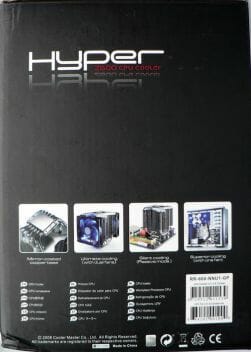
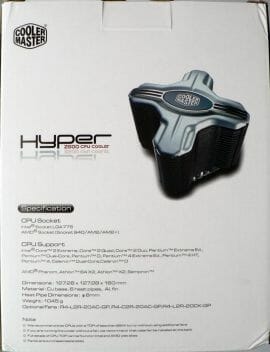
There is another box inside this package that is made of thick cardboard. When you open it, you find cooler heatsink sitting between polyurethane foam pads and accessories packed in individual plastic bags in the lower box sections:
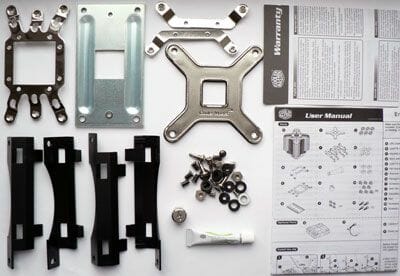
Let me list all the bundled accessories from left to right and from the top row to the bottom:
- Cooler retention bracket for AMD K8 mainboards;
- Backplate for AMD K8 mainboards;
- Two retention brackets for Intel platforms with LGA 775 socket;
- Backplate for Intel LGA 775 mainboards;
- Warranty sheet;
- Four plastic retentions holding a fan on the heatsink;
- A set of screws, nuts, plastic pads and rubber rings;
- A cross-cut screwdriver button;
- Cooler Master thermal compound;
- Step-by-step assembly and installation guide in several languages.
Cooler Master Hyper Z600 comes without any rotation speed controllers or fans, as it is positioned primarily as an absolutely silent passive cooler.
Now let’s take a closer look at its design and features.
Design and Functionality
Well, when we open the box we see a pretty heavy and large cooling solution. To be more exact, Cooler Master Hyper Z600 measures 127.28 x 127.28 x 160 mm and weighs 1045g:
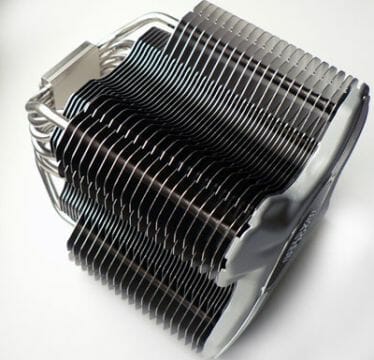
The cooler is based on six copper nickel-plated heatpipes 6mm in diameter that go through the copper base also covered with a thin layer of nickel alloy:
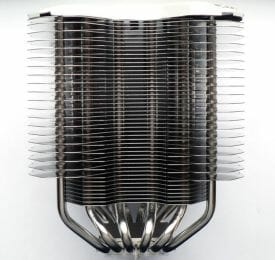
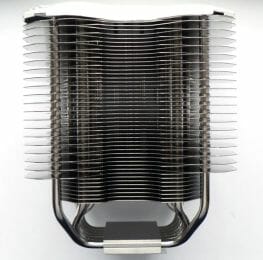
The heatpipes hold an array of 48 aluminum plates. The heatsink array uses 0.4~0.5mm plates of two kinds: 20 large X-shaped plates and 28 smaller plates, alternating with the large ones that form the center of the heatsink array. The gap between the large plates is 4mm, and so is the gap between the two smaller plates inserted between the large ones:
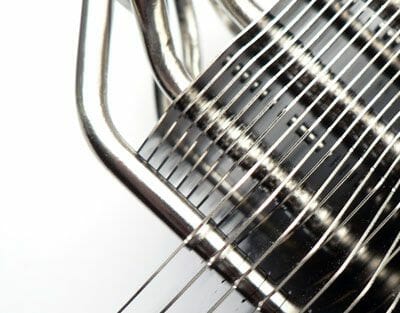
There are only 7 smaller plates with a 2mm gap in the lower part of the heatsink. So, all in all, we can say that the heatsink plates of Cooler Master Hyper Z600 are spaced out at 2mm from each other, except on the edges. I have to say that it is too little for the cooler to cope with overclocked CPUs with natural convection only. Looks like Cooler Master engineers do know it very well, as they claim passive Hyper Z600 can cool processors with maximum 89W heat dissipation, which is the average operational value for non-overclocked processors running under high workload. At the same time, the small gap between the heatsink plates gives us hope that the cooler efficiency will improve dramatically once we install the fans on top of its heatsink and speed them up. We will certainly check it out during our test session, and now let’s continue with the discussion of the cooler design.
The heatpipes are placed into the heatsink body in a very interesting manner:
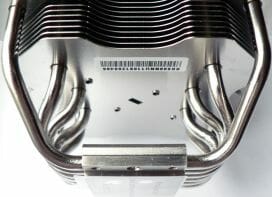
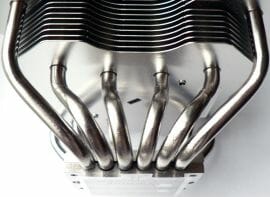
Four middle heatpipes go through the heatsink base and then bend like an arc distributing the heat more evenly over the heatsink plates. The two outer heatpipes that bear the smallest thermal workload go only over the edges of the large X-shaped heatsink plates. By the way, the photos above show very clearly that the few holes that seem to be necessary for the cooler assembly are the only ones: there are no other holes or slits in the heatsink plates. So, considering the cooler size, the heat dissipating surface of its heatsink is fairly large, although the manufacturer doesn’t state how big it is. And in order to calculate this value, we would have to take the cooler apart and remove one large and one small plate from the heatsink.
The heatpipe ends are covered with an aluminum lid at the top. The lid has a decorative plastic pad with Cooler Master Company logo on it:
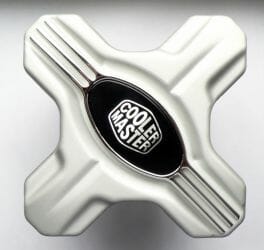
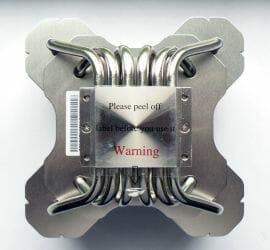
The cooler base is covered with protective plastic film warning you that it needs to be removed before installation. The cooler base is finished pretty well and the round machine traces remind us of Thermalright coolers:
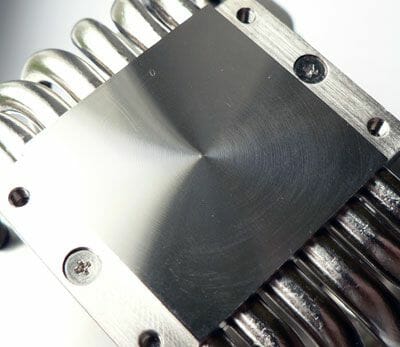
At the same time we were very pleased that unlike Thermalright solutions the new Cooler Master product has ideally even surface. The thermal compound imprint on the glass and on the processor heat-spreader turned out impeccable:
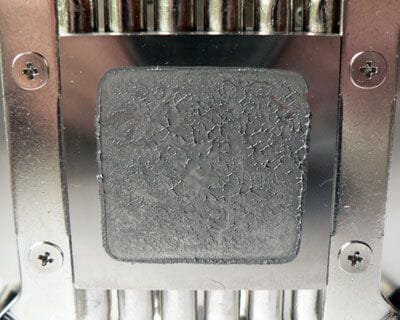
Winding up the discussion of the cooler base I would like to add that heatpipes lie in special grooves and are so neatly soldered to the base that we could barely notice the soldering:
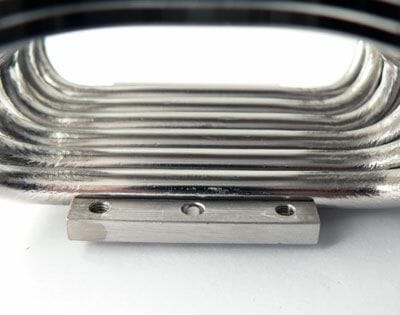
At the same time, we couldn’t figure out what was used to ensure proper contact between the heatpipes and the aluminum heatsink plates, as we didn’t see any traces of thermal glue or soldering. I would only like to add that the plates sit very snuggly on the heatpipes. So, you shouldn’t worry about them shifting or rattling.
Now we are going to talk about attaching the fans to Cooler Master Hyper Z600 and about the actual cooler installation.
Fan Attachment and Installation Tips
As you remember, Hyper Z600 is bundled with four plastic fan retentions. Note that it can accommodate two 120 x 120 x 25mm fans (a pair of retentions per fan). First you have to fasten the retention brackets to the fan with bundled screws:
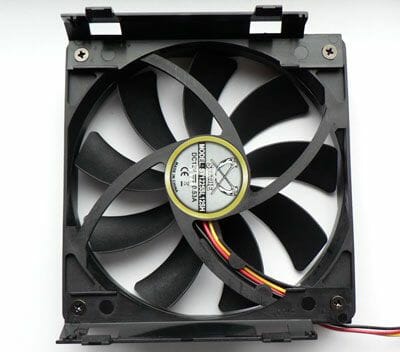
Each bracket has two clips that should catch to any of the heatsink four sides:
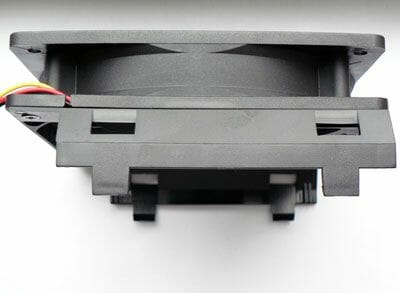
This entire procedure takes less than a minute and you end up with an active cooler. Moreover, Hyper Z600 becomes not just an active cooler, but a super-cooler:
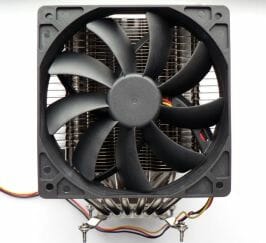
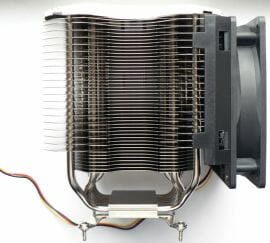
You should remember, however, that this new cooler with two fans attached to it will weigh more than 1.3 kg, although this weight shouldn’t really discourage a true overclocker as the cooler retention will go all the way through the mainboard PCB. I would like to point out that the fan retention clips lock very securely that is why we didn’t detect any vibration or additional noise during the entire test session.
Now we have to say a few words about the actual cooler installation. If you have been reading our cooler reviews including those of Cooler Master products for a while, there will be nothing new to you here. Te cooler can be installed suing one of the two bundled retention sets that are screwed on to the cooler base with four screws:
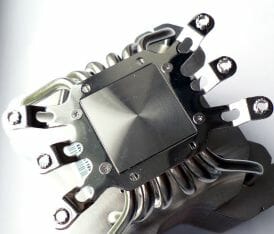
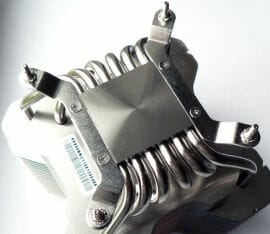
Since the cooler base is perfectly square, you can attach the Socket 754/939/940/AM2(+) retention to the cooler base either way and hence turn the cooler facing in any direction. Of course, LGA 775 platforms never had the same limitation as AMD K8 ones. However, since Hyper Z600 heatsink is completely symmetrical and the heatpipes are very compactly packed at the cooler base, turning the cooler facing different ways doesn’t really change anything, unlike other solutions out there.
Make sure that you insert the retention screws into the brackets before attaching them to the cooler base. If you never read manuals, bear in mind that these screws should go in counterclockwise.
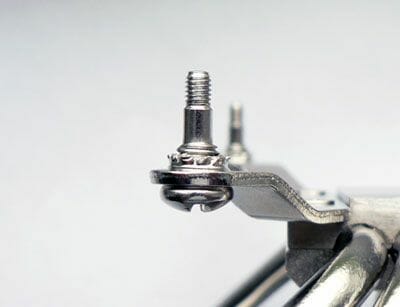
After that put rubber rings onto these screws as they will protect the mainboard wiring against any possible physical damage during the cooler installation. The best would be to glue these rings to the mainboard PCB.
And now you can apply a thin layer of thermal compound to the CPU, turn the cooler upside down on the desk and then place the mainboard turned upside down on top of it. I advise you to install this massive cooler exactly like that and not as you would normally do (when the cooler goes on to the board). Now tighten the screw-nuts through the backplate:
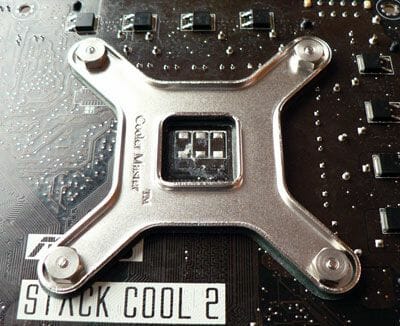
This is when the bundled cross-cut screwdriver button comes in handy. The screws should be tightened evenly, in diagonal pairs. The hold-down pressure against the CPU is very high. Of course, you can also use plastic washers instead of a backplate, but in this case the heavy cooler will most likely bend the PCB a little.
Now all you need to do is install the mainboard with the cooler on it into the system case and attach the fan(s) to the heatsink:
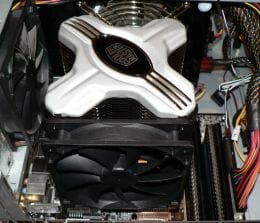
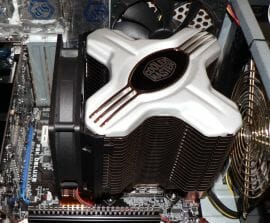
Only when the whole thing is already inside you realize how massive it actually is. Of course, it is nothing like the gigantic Scythe Orochi, but still a very large cooler. And with two fans attached it turns even larger (~180mm wide):
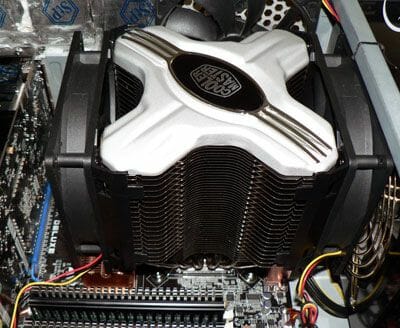
As we found out later, with two fans installed for air intake and exhaust the cooler becomes the most efficient. If you have the fans direct the airflow towards the case rear panel, the CPU temperature under peak workload will be 2~3ºC higher than in case the cooler is installed as shown above.
Technical Specifications and Pricing
We summed up all the technical details and pricing info on Cooler Master Hyper Z600 in the table below:
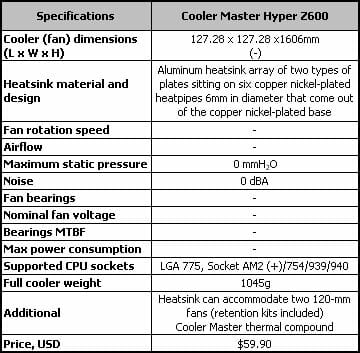
Testbed and Methods
Cooler Master Hyper Z600 cooler and its today’s competitor were tested in two modes: in an open testbed when the mainboard sits horizontally on the desk and the cooler is installed vertically, and in a closed testbed with the mainboard in vertical position.
Our testbed remained the same throughout the entire test session and featured the following configuration:
- Mainboard: ASUSTek P5K Deluxe/WiFi-AP (Intel P35), LGA 775, BIOS 0812
- Processor: Intel Core 2 Extreme QX9650 (3.0GHz, 1.25V, 2x6MB L2 cache, 4x333MHz FSB, Yorkfield, C0)
- Thermal interface: Arctic Silver 5
- Graphics card: Chaintech GeForce 9800 GTX GDDR3 512MB / 256bit, 675/2200MHz
- Memory:
- 2 x 1024MB DDR2 Corsair Dominator TWIN2X2048-9136C5D (1142MHz / 5-5-5-18 / 2.1V);
- 2 x 1024MB DDR2 CSXO-XAC-1200-2GB-KIT DIABLO (1200MHz / 5-5-5-16 / 2.4V).
- Disk subsystem: Samsung HD501LJ (SATA-II, 500GB storage capacity, 7200rpm, 16MB cache, NCQ)
- Optical drive: Samsung SH-S183L SATA-II DVD RAM & DVD±R/RW & CD±RW
- System case: System case: ASUS ASCOT 6AR2-B Black&Silver (ATX) with 120mm ~960RPM Scythe Slip Stream fans for air intake and exhaust (the fans are installed on silicon spindles), and the same 120mm ~840RPM fan on the side panel
- Control and monitoring panel: Zalman ZM-MFC2
- Power supply: Enermax Galaxy EGA1000EWL 1000W (a default 135mm fan for intake; and 80mm fan for air exhaust)
All tests were performed under Windows XP Professional Edition SP2. SpeedFan 4.34 Beta 44 was used to monitor the temperature of the CPU, reading it directly from the CPU core sensor:
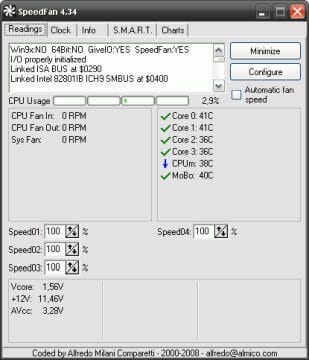
The mainboard’s automatic fan speed management feature was disabled for the time of the tests in the mainboard BIOS. The CPU thermal throttling was controlled with the RightMark CPU Clock Utility version 2.35.0:
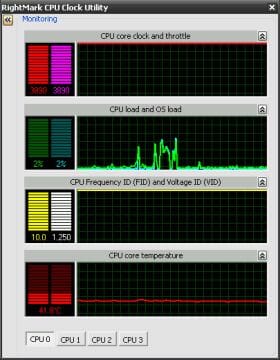
The CPU was heated up with OCCT (OverClock Checking Tool) version 2.0.0a in a 23-minute test with maximum CPU utilization, during which the system remained idle in the first 1 and last 4 minutes of the test:
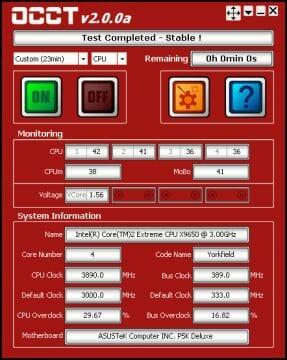
I performed at least two cycles of tests and waited for approximately 20 minutes for the temperature inside the system case to stabilize during each test cycle. The stabilization period in an open testbed took about half the time. The maximum temperature of the hottest CPU core of the four in the two test cycles was considered the final result (if the difference was no bigger than 1°C – otherwise the test was performed at least once again). Despite the stabilization period, the result of the second test cycle was usually 0.5-1°C higher.
The ambient temperature was checked next to the system case with an electronic thermometer that allows monitoring the temperature changes over the past 6 hours. During our test session room temperatures varied between 21 ~ 21.5°C. It is used as a staring point on the diagrams. Note that the fan rotation speeds as shown in the diagrams are the average readings reported by SpeedFan, and not the official claimed fan specifications.
The noise level of each cooler was measured according to our traditional method described in the previous articles with the help of an electronic noise meter – CENTER-321. The subjectively comfortable noise level was considered 34.5dBA and is marked with a dotted line in the diagram. The ambient noise from the system case without the CPU cooler didn’t exceed 32.5dBA when measured at 1m distance.
We decided to compare the performance of our today’s hero – Cooler Master Hyper Z600 – against that of ZEROtherm NV120 Premium cooler:
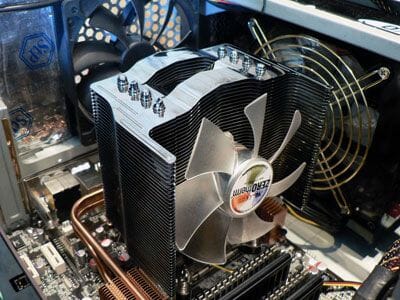
We tested this cooler in two modes: with the fan rotating at ~1320RPM with moderate noise and at pretty noisy maximum fan rotation speed of ~2760RPM. Cooler Master Hyper Z600 was tested not only in passive mode, but also with one and then with two Scythe SlipStream 120 fans working at ~900RPM and ~2000RPM. Two fans were attached at the opposite sides of the heatsink for air intake/exhaust.
Cooling Efficiency and Acoustic Performance
Cooling Efficiency Tests
We started checking out the cooling efficiency of Cooler Master Hyper Z600 solution with the tests in passive mode. A quad-core Intel Core 2 Quad QX9650 processor overclocked to 3700MHz at 1.45V Vcore (~1.43V according to the monitoring data) remained stable cooled with a passive Hyper Z600 in an open testbed. The hottest CPU core in this case didn’t exceed 90ºC. Unfortunately, we couldn’t overclock with a passive cooler any further even in an open testbed, not to mention the closed system case. However, I shouldn’t be complaining because the obtained result is exactly 50MHz better than what we achieved with a copper (!) 1-kg Scythe Ninja and 50MHz lower than what we got from a gigantic Scythe Orochi.
Moreover, Cooler Master Hyper Z600 managed to keep without going into throttling a hot processor like Intel Core 2 Quad Q6600. And not just keep it running, but ensure its stable operation after overclocking from the nominal 2400MHz to 3420MHz at 1.4325V (~1.41V according to monitoring data). The hottest processor core warmed up to 94ºC:
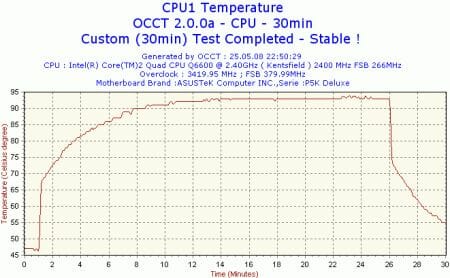
Well, I believe the performance of passive Cooler Master Hyper Z600 is more than great. Now let’s check out its cooling efficiency in active mode, namely, with a fan and then with two fans working at different speeds.
So, when we equipped Hyper Z600 with one quiet fan, we managed to overclock our quad-core processor to 3.89GHz with the Vcore increased to 1.5757V in the mainboard BIOS. The monitoring utilities reported the voltage a little bit lower than set in the mainboard BIOS, i.e. around 1.54~1.56V. The results obtained with a new cooler and its competitor are given on the diagram below:
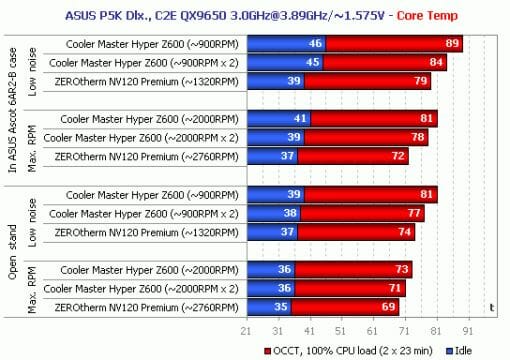
First of all I would like to point out that Cooler Master Hyper Z600 boasts excellent potential. By adding a second quiet fan (~900RPM) we could drop the processor temperature by another 4-5ºC under peak workload. With only one high-speed fan rotating at ~2000RPM the improvement over a single 900RPM fan is 8ºC. And two powerful fans installed for air intake/exhaust help Hyper Z600 cool the CPU by 10-11ºC better than a single 900RPM fan. As a result, the newcomer catches up with the competing super-cooler in an open testbed. Hyper Z600 loses more to ZEROtherm cooler inside the system case because of its extremely large size.
And now let’s see how installing one/two fans with different rotation speeds onto Hyper Z600 will affect CPU overclocking results:
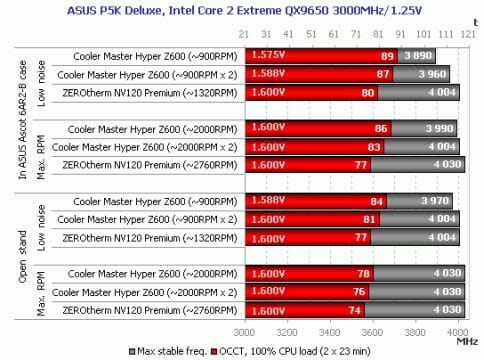
The results here are also quite logical. I would like to say that we overclocked our quad-core processor almost to its absolute maximum with Cooler Master Hyper Z600. As far as I remember, our test QX9650 could work stably at 4070MHz and 1.6V Vcore only with Thermalright Ultra-120 eXtreme cooler, however, this is too little of a difference to base your cooler buying decision on.
Acoustic Tests
We measured the level of noise generated by our today’s testing participants from a 3cm, 1m and 3m distance. The results are given on the diagram below:
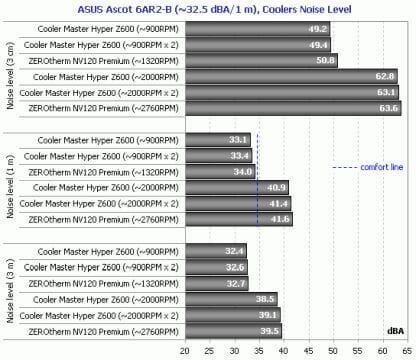
I believe there is nothing I could really add here.
Conclusion
Cooler Master Hyper Z600 turned out a very interesting new solution. Probably the most interesting cooler of all we have tested over the last two-three months. First of all, this cooler will be of great value and interest to the owners of quiet PCs and large computer cases who do not need to squeeze all the juices out of their CPUs. As you could see from our today’s experiments, Hyper Z600 can cope easily with a new quad-core QX9650 running at 3.7GHz or old Q6600 working at 3.42GHz. But the most remarkable thing is that this is far not the maximum of the cooler’s potential.
With one or, better, two quiet fans, the modest passive Hyper Z600 turns into a deadly weapon against hot overclocked processors. And a pair of high-speed fans brings its performance up to the level of recognized leaders among contemporary air coolers. Even equipped with two high-speed fans the newcomer didn’t manage to completely catch up with ZEROtherm Nirvana NV120 Premium. However, the Nirvana in passive mode on a quad-core processor gives up at 3.45GHz already, while Hyper Z600 can do much more, as you know by now.
All in all, this solution will undoubtedly find its place in the market even despite the relatively high price of $60.